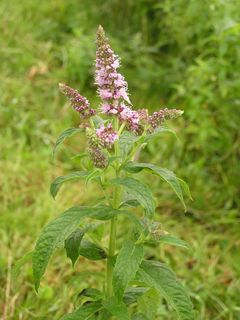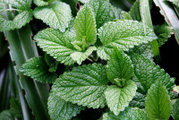Mentha
2007 Schools Wikipedia Selection. Related subjects: Plants
| iMentha | ||||||||||||
|---|---|---|---|---|---|---|---|---|---|---|---|---|
 Mentha longifolia
|
||||||||||||
| Scientific classification | ||||||||||||
|
||||||||||||
|
|
||||||||||||
|
See text |
Mentha (mint) is a genus of about 25-30 species of flowering plants in the family Lamiaceae, with a subcosmopolitan distribution, seven from Australia, one in North America, and the others from Europe and Asia; several hybrids also occur.
According to Greek mythology, the plant was named after Minthe.
They are aromatic perennial herbs, growing to 10-120 cm tall, with wide-spreading underground rhizomes and erect, branched stems. The leaves are arranged in opposite pairs, simple oblong to lanceolate, often downy, and with a serrated margin. The flowers are produced in clusters ('verticils') on an erect spike, white to purple, the corolla two-lipped with four subequal lobes, the upper lobe usually the largest. The fruit is a small dry capsule containing 1-4 seeds.
- Species
- Mentha aquatica – Water mint, or Marsh mint
- Mentha arvensis – Corn Mint, Wild Mint and Japanese Peppermint
- Mentha arvensis var. sachalinensis" - Sachalin Mint
- Mentha asiatica
- Mentha australis
- Mentha canadensis (syn. M. arvensis var. canadensis)
- Mentha cervina
- Mentha citrata (syn. M. odorata) – Bergamot mint (smells like Bergamot)
- Mentha crispata
- Mentha cunninghamii
- Mentha dahurica
- Mentha diemenica
- Mentha gattefossei
- Mentha grandiflora
- Mentha haplocalyx
- Mentha japonica
- Mentha kopetdaghensis
- Mentha laxiflora
- Mentha longifolia - Horse Mint
- Mentha pulegium – Pennyroyal
- Mentha requienii – Corsican mint
- Mentha sachalinensis
- Mentha satureioides
- Mentha spicata (syn. M. viridis) – Spearmint, Curly mint
- Mentha suaveolens (syn. M. rotundifolia) – Apple mint (smells like apples) and Pineapple mint (a variegated cultivar of Apple mint)
- Mentha vagans
- Selected hybrids
- Mentha × dalmatica (M. arvensis × M. longifolia)
- Mentha × dumetorum (M. aquatica × M. longifolia)
- Mentha × gracilis (M. arvensis × M. spicata) - Bushy Mint
- Mentha × maximilianea (M. aquatica × M. suaveolens)
- Mentha × muelleriana (M. arvensis × M. suaveolens)
- Mentha × piperita (M. aquatica × M. spicata) – Peppermint, Chocolate mint
- Mentha × rotundifolia (M. longifolia × M. suaveolens) - False Apple-mint
- Mentha x smithiana (M. aquatica × M. arvensis × M. spicata)
- Mentha × verticillata (M. arvensis × M. aquatica)
- Mentha × villosa (M. spicata × M. suaveolens; syn. M. cordifolia) - Apple-mint
- Mentha x villosonervata (M. longifolia × M. spicata) - Sharp-toothed Mint
Mints are used as food plants by the larvae of some Lepidoptera species including Buff Ermine.
Cultivation and uses
Mints are generally vigorous, spreading plants that tolerate a wide range of conditions, but thrive where there's abundance of water. They can be highly invasive plants, so caution should be taken in cultivation or it can take over an entire garden.
The most common and popular mints for cultivation are peppermint (Mentha × piperita), spearmint (Mentha spicata), and (more recently) pineapple mint (Mentha suaveolens). The dark green leaves have a pleasant warm, fresh, aromatic, sweet flavor with a cool aftertaste. Mint essential oils are used to flavor food, candy, teas, breath fresheners, antiseptic mouth rinses, and toothpaste. Mint leaves are used in teas, beverages, jellies, syrups, and ice creams. In Mid-Eastern cuisines, mint is used on lamb dishes. In British cuisine, mint sauce is popular with lamb. Mint leaves generally refer to dried spearmint leaves. Pennyroyal and Corsican Mint have a much stronger odour and flavor, and potentially harmful medicinal effects. Pennyroyal resembles the other mints, but Corsican mint is unusual in the fact that it is a low, mossy ground-covering plant. The pineapple mint is particularly mild and popular.
Mint essential oil and menthol are extensively used as flavourings in drinks, chewing gum and desserts/ candies; see mint (candy) and mint chocolate. The substances that give the mints their characteristic aromas and flavours are:
- menthol: the main aroma of Spearmint, Peppermint, and Japanese Peppermint (a major commercial source).
- pulegone: in Pennyroyal and Corsican Mint.
The mint family, Lamiaceae, includes many other aromatic herbs, including most of the more common cooking herbs, including basil, rosemary, sage, oregano, and catnip. In common usage, several other plants with fragrant leaves may be erroneously called a mint. Vietnamese Mint, commonly used in Southeast Asian cuisine, is not a member of the mint family. In Central and South America, mint is known as yerbabuena (literally, "good herb"), and in Pakistan, it's called Podeena.
Medicinal and cosmetic uses
Mint was originally used as a medicinal herb to treat stomach ache and chest pains. During the middle ages, powdered mint leaves were used to whiten teeth. Mint tea is a strong diuretic. Mint also aids digestion.
Menthol is an ingredient of many cosmetics and perfumes. Menthol and mint essential oil are also much used in medicine as component of many drugs, and are very popular in aromatherapy. A common use is as an antipruritic, especially in insect bite treatments (often along with camphor).
It is also used in cigarettes as an additive, because it blocks out the bitter taste of tobacco and soothes the throat.

